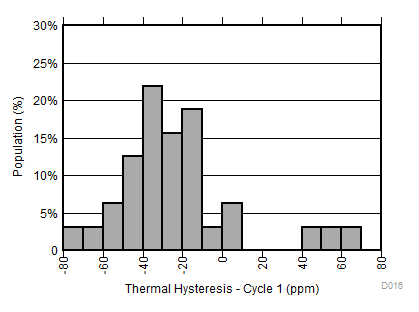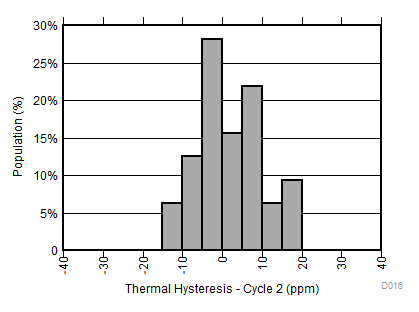SBAS804F September 2017 – June 2021 REF3425 , REF3430 , REF3433 , REF3440 , REF3450
PRODUCTION DATA
- 1 Features
- 2 Applications
- 3 Description
- 4 Revision History
- 5 Device Comparison Table
- 6 Pin Configuration and Functions
- 7 Specifications
- 8 Parameter Measurement Information
- 9 Detailed Description
- 10Application and Implementation
- 11Power Supply Recommendations
- 12Layout
- 13Device and Documentation Support
- 14Mechanical, Packaging, and Orderable Information
Package Options
Mechanical Data (Package|Pins)
- DBV|6
Thermal pad, mechanical data (Package|Pins)
Orderable Information
8.3 Thermal Hysteresis
Thermal hysteresis is measured with the REF34xx soldered to a PCB, similar to a real-world application. Thermal hysteresis for the device is defined as the change in output voltage after operating the device at 25°C, cycling the device through the specified temperature range, and returning to 25°C. The PCB was baked at 150°C for 30 minutes before thermal hysteresis was measured. Hysteresis can be expressed by Equation 1:
Equation 1. 

where
- VHYST = thermal hysteresis (in units of ppm)
- VNOM = the specified output voltage
- VPRE = output voltage measured at 25°C pre-temperature cycling
- VPOST = output voltage measured after the device has cycled from 25°C through the specified temperature range of –40°C to +125°C and returns to 25°C.
Typical thermal hysteresis distribution is as shown in Figure 8-4 and Figure 8-5.
 Figure 8-4 Thermal Hysteresis
Distribution Cycle 1 (VOUT)
Figure 8-4 Thermal Hysteresis
Distribution Cycle 1 (VOUT) Figure 8-5 Thermal Hysteresis Distribution Cycle 2
(VOUT)
Figure 8-5 Thermal Hysteresis Distribution Cycle 2
(VOUT)